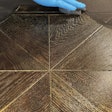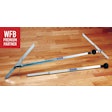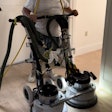The Problem
I recently was asked by a local contractor to look at a complaint on a finish recoat of a wood floor. The floor had been down for approximately one year. The installation was 2 1/4-inch red oak strip laid over a vapor barrier and 3/4-inch tongue-and groove plywood. The original finish on the floor was an oil-modified polyurethane, which had been deeply scratched while the homeowner was rearranging furniture. The contractor used waterborne finish for the recoat, and that finish did not adhere properly, resulting in "fish-eyes."
The Procedure
The contractor installed the floor; therefore, he was confident that moisture was not a problem. He checked the moisture conditions of the floor prior to making any repairs and found them to be within the correct range for the geographic area.
Although the scratches penetrated into the wood, they were not deep enough to warrant aboard replacement. The damaged area was in a prominent location of the room, and the homeowner requested a screen and recoat of the entire room so the repair wouldn't be obvious. The contractor and homeowners decided a waterborne finish would be the best to use since the family planned to stay in the house during the time of the repair.
The contractor used his edger and scraper to prepare the surface of the damaged areas, and he proceeded to screen the rest of the floor with a 150-grit screen to achieve the proper level of intercoat adhesion, as recommended by the finish manufacturer. The floor was prepped for a second coat with a blue pad to ensure the proper bonding. The coating then was completed.
The problem surfaced several days later, when the newly applied finish started to "fish-eye."
The Cause
With some research, we were able to backtrack to the root of the problem. In discussing the step by-step process of the job, we discovered that the contractor, who was relatively new to the business, used a treated cheesecloth-type tack cloth to tack the floor. This being the first time he had used a waterborne finish, the contractor figured the finish was to blame, but in reality, the tacky substance used in the tack cloth had caused the finish to not adhere properly to the floor. It is very likely that the problem would have occurred with any type of finish.
How to Fix the Floor
At this point, the contractor was faced with trying to fix the fish-eye spots or resanding the entire floor. In order to avoid the potential formore problems down the road, we felt it was best to resand the floor and start fresh with a clean surface.
He started with a 60-grit belt to remove the finish, since the floor was already flat, and finished with a 100-grit. He screened with a 100-grit screen. After vacuuming the floor thoroughly, he tacked the floor with a clean, slightly damp white tack cloth. He reapplied the finish according to the manufacturer's recommendations with no problems. A blue pad was used to guarantee the proper level of abrasion between coats.
In the Future
Take the time to read the manufacturer's recommended method for surface preparation, i.e. proper sanding sequence and cleaning prior to applying the finish. Different finishes require different products and preparation methods, and always keep the potential for contamination in mind. A little extra time to read directions (or even to talk with your distributor or manufacturer) at the start of the job could save you a lot of time in the end.
Also, when using a product that is new to you,test it out on a small portion of the floor first, or even better, try it on a test panel in your shop. Experimenting with a customer's floor is never a good idea. Although contractors may experience more problems with finishes than any other product, the problem is rarely the finish itself.
Remember, when a mistake does happen, you will be judged by your customers on how you respond to the complaint. It is very important to take the extra effort to be aggressive in resolving the problem as quickly as possible on the first attempt.
Once the job is satisfactorily completed, here is a suggestion to repair the customer's damaged confidence: Give the homeowners a small gift such as a flower arrangement, dinner gift certificate or video rental certificate to compensate them for the inconvenience. Each customer is a potential referral for another job. Try to ensure that your company name is associated with a positive experience.
































